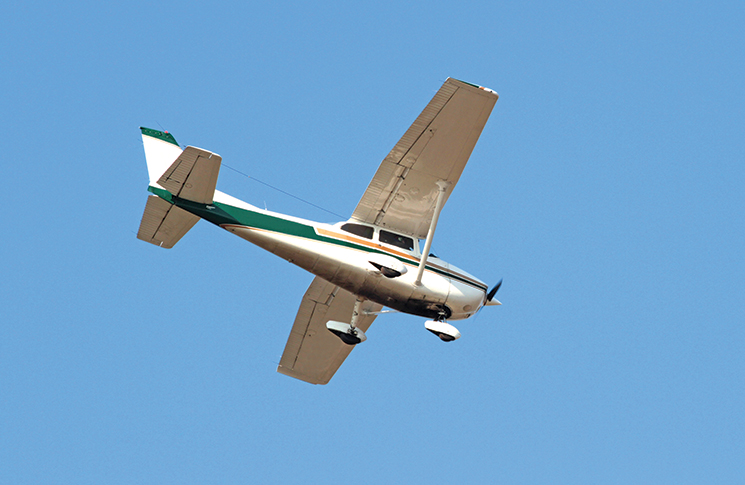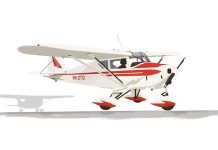Knowing when and how to perform a go-around is a perishable skill that needs practice and revision after the enforced groundings of the past two years Kreisha Ballantyne writes
It had been 2 years since I had flown. A combination of fire, flood and pestilence had kept me, and most of Australia’s VFR private pilots, on the ground.
A week before my flight, the VFRG became my bedtime reading. The night before my flight, I had visualised everything: my walkaround, radio calls, the taxi out to the runway and the circuit at Camden. As someone who has made a partial living reading and writing about ATSB reports, I knew I would need to be on guard on my first flight.
The next morning, the weather was splendid. I threw the roof down on the car, activated my flying playlist and set off for Camden. Despite normally flying at Bankstown, I’d chosen Camden for this mid-week flight as it’s where I did my initial training and the aerodrome I’ll always think of as ‘home’.
Being back in the av-saddle was marvellous. I was pleasantly surprised how much of the muscle memory components remained intact: steep turns, stalls, general handling and, fortunately for me, the go-around.
However, I had forgotten to plan for a potential go-around. I ended up conducting 2 – in a session that was largely about practising landings. The first was instructed by the tower as the aircraft before me was slow in vacating the runway; the second was self-prescribed as I experienced an unexpected fear of the ground due to not casting my eyes to the end of the runway, causing me to flare too high.
Go-arounds are part of normal flying. We are human. We make occasional mistakes.
One thing I’ve noticed about returning to flight after a long break is that while the muscle memory components of flight do remain, the procedural factors are the first to atrophy.
With my go-around, muscle memory kicked in and I remembered what to do: increase power, steady with rudder, move to the right of the runway and reconfigure the aircraft. However, my procedural memory was a little lacking: my instructor had to step in and make my radio call on the second go-around, which I’d instigated due to dissatisfaction with the flare.
In the flight debrief, my instructor commended my decision to go around and we had a chat about technique, but also about decision-making. He said he occasionally witnesses hesitancy regarding the go-around, with the implication that if your landing isn’t perfect, you’ve ‘stuffed up’.
He also stressed the importance of not leaving the go-around until the last minute. And Lilydale-based flying instructor Graham Bunn says it’s vital to teach the importance of the go-around in the ab-initio stages.
‘I make a big deal of the fact, during early circuit training, that go-arounds are a perfectly acceptable thing to do,’ he says. ‘The mechanics of a go-around are a small part of it: the most important thing is that a pilot should never be hesitant or afraid or ashamed to make the decision.
‘To reinforce the point, I explain that I log literally every go-around (mine or a student’s) so I can tell you exactly when the last one occurred. And then I explain that if I have not done one in a long time, there must be one of only 2 possible explanations: either I am a brilliant pilot or I am full of it. ‘Inviting a student to say which is true always gets a grin, but the point is to get across the really important idea that go-arounds are part of normal flying. We are human. We make occasional mistakes. Others make much more frequent mistakes (naturally), but a go-around is often the best way by far to recover from them.’
If there’s anything about your approach that is looking unstable – too high a crosswind, wind shear or turbulence – prepare to go around.
Why go around?
The basic rule of thumb is a stable approach leads to a good landing. If there’s anything about your approach that is looking unstable – too high a crosswind, wind shear or turbulence – prepare to go around.
Bear in mind, gusting winds must be taken into account during a go-around when the aircraft is in ground effect during the flare. When the gusts are roughly 10 knots and above, remain on high alert to initiate a go-around.
Be aware that if the go-around is commenced during the peak of a gust and then the gust subsequently dies, the airspeed will drop off and there’s a chance the aircraft could settle to the ground. Ensure you do not pull up the nose to counteract the sink or you could end up striking the runway; for example, see ATSB report AO-2014-090.
In this incident, the approach was steeper than usual and, as the student commenced the flare, the aircraft was still too high above the ground. The student initiated a go-around and almost immediately the aircraft tail struck the runway. The aircraft rolled rapidly to the left and stalled. It then turned further left and continued across the taxiway and through a wire perimeter fence. The student was uninjured but the aircraft sustained substantial damage.
Another reason to initiate a go-around is if your aircraft is floating down the runway.
Floating occurs when the pilot enters a flare with excessive airspeed and maintains a level or slightly nose-high attitude; the pilot waits and flies over much of the runway while the excess energy bleeds off, to make a safe landing. However, unless the landing is on a very long runway, a go-around should be initiated as the runway is rushing by.
Bouncing is also a good reason to go around. This is a common occurrence for students and the bounce can be terrifying, but quickly remedied by going around and avoiding a series of bounces and a potentially humiliating porpoised own the runway.
Instead of ‘saving’ the landing, lowering the nose slightly will avoid bouncing any higher and then adding full power and building speed during a gradual climb will rescue the situation. Once airspeed is gained, a normal go-around climb can be established.
The art of the go-aroundMagazine contributor Thomas P Turner covered the mechanics of go-arounds in his excellent article, ‘Commanding the go-around’, published on the Flight Safety Australia website in 2016. However, as many of us are as rusty as our whizz wheels from too much enforced time on the ground, I’d like to take a moment to refresh these techniques. Basically, the go-around procedure can be broken up into 5 steps:
PowerMost aircraft call for full power at the commencement of a go-around. Check your flight manual, of course, but the general consensus is: full power, full propellor speed, mixture full rich. Once full power is applied, it should remain constant for the climb phase of the procedure. Elevator pressureOn final approach, the trim will be in a relatively nose-up position. The exact position is determined by many factors, including the aircraft’s current weight and centre of gravity location. With high-powered aeroplanes, the nose may pitch up aggressively into a dangerous attitude during a go-around, especially when it has an aft CG. Pilots of powerful aircraft must be ready to handle this rapid attitude change. In most training aeroplanes, the final approach trim setting is very near the normal take-off trim position. To remain in trim as the aircraft transitions through the configuration change, the trim mechanism must be moved morenose-down, until reaching the normal climb phase setting. Stabilise the aircraftOne common go-around occurrence is loss of directional control in the initial stages of the procedure. Several accidents documented by the ATSB state loss of control during a go-around as a major cause, including these 2 night accidents: AO-2018-038-final.pdf and AO-2013-163_final.pdf. As Turner says in his article: The directional change is usually the result of high forces from the propeller factor (‘P-factor’), gyroscopic forces from the spinning propeller and pitch attitude changes, and slipstream effects – combined, known as the ‘left-turning tendencies’. These forces are greatest at high power and high angles of attack – 2 go-around threat factors in their own right. Flaps (and landing gear)Managing the flight controls during a go-around becomes much easier once flaps/gear have been gradually retracted. Lift generated by the wings decreases incrementally as the flaps are retracted; with decreasing lift, the aircraft climb rate is likely to decrease, or momentarily stop, as well. Drag decreases as the flaps are retracted, allowing the aircraft to accelerate to a rate that will generate lift equal to that lost by the retracting flaps. The goal is to do this without losing altitude. By following the recommended speeds in the aircraft’s operating handbook, once the pitch has been stabilised and power has been applied, the aircraft will start gaining altitude. Climb speed and trimEnsure you’re climbing out at the aircraft’s published speeds relative to any flap/gear still extended, that appropriate rudder is applied and the aircraft is trimmed for the climb. At circuit height, level out and retrim and continue flying the circuit as normal. |
Better late than never
The ATSB’s investigation into the collision with terrain of both a Cessna 206, registration VH-WZX, at Apollo Bay Airfield in Victoria and a Van’s RV-6A aircraft, registered VH-OAJ, underlines the importance of pilots executing an early and correctly executed go-around during approach and landing.
On 31 January 2018, the pilot of VH-WZX touched down at Apollo Bay Airfield and then bounced and floated along the runway. The pilot attempted to complete the landing, but the aircraft continued to float and drift right, over the adjacent grass fly-over area, where it possibly bounced for a second time. With one quarter of the runway remaining, the aircraft touched down on the grass and bounced again.
One common go-around occurrence is loss of directional control in the initial stages of the procedure.
After commencing a late go-around, the pilot did not immediately follow the go-around procedure to retract the flaps to the 20-degree position as directed by the aeroplane flight manual. The aircraft did not climb as expected and struck the airfield boundary fence and continued flying. After striking the fence, the pilot again deviated from the aircraft manufacturer’s recommended go-around procedure and the aircraft descended and impacted a tree. The pilot then completed a left circuit for the runway and landed safely.
On 18 March 2018, the pilot of a Van’s RV-6A aircraft, registered VH-OAJ, was conducting a private flight from Camden to Somersby, NSW. During landing, the aircraft initially touched down, then bounced several times, overran the end of the runway and impacted the side of a watercourse. The aircraft sustained substantial damage. The pilot sustained serious injuries and succumbed to his injuries 2 days later.
The ATSB found the aircraft touched down at high speed and at a point on the runway that reduced the available stopping distance and there were no indications of an attempt at a go around. As a result, the aircraft overran the runway and subsequently collided with terrain.
ATSB Executive Director Nat Nagy says the incident highlights the need for pilots to execute an early go-around as recommended by the aircraft’s manual.
‘The best way to avoid a late go-around is to anticipate and plan an early decision point for when to commence a go-around,’ he says, ‘We support the advice of the Federal Aviation Administration, who suggest that if the landing cannot be made in the first third of the runway, you should execute a go-around.’
Why take a risk? If in doubt, go around.






Comments are closed.